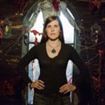Haunted houses, abandoned prisons and bungee jumping are just a few anxiety-inducing examples of what Margee Kerr, author and sociologist, got herself into while writing “Scream: Chilling Adventures in the Science of Fear.”
Kerr takes a deep dive into the visceral and enthralling world of fear as she embarks on frightful adventures. Throughout the book, Kerr explores how and why thrill seekers engage in potentially threatening activities.
Broken up into four parts (Physical Thrills, Psychological Chills, Real Fear and Bringing It Home), “Scream” tackles the science behind fear while remaining unabashedly satirical.
While the book errs more toward the scientific side of fear, “Scream” is a fun spirited examination of what makes the psyche tick.
Being that there are no real scares and only first and secondhand accounts of them, Kerr is sure to keep readers on their toes with quick wit and nail-biting experiences.
Kerr penned the juicy details about her time spent observing people in a highly vulnerable state through peepholes at haunted houses.
“I hear their screams, and occasionally I see the tears in their eyes,” Kerr wrote. “I’ve seen men push their girlfriends out of the way as they try to move and others drop to their knees and scream for God.”
Fear is an all too real element in the lives of many, whether it be voluntary or otherwise. There is no surefire way to avoid it, making the topic of fear itself an intriguing subject to further investigate.

Margee Kerr is a sociologist that studies fear and wrote the book, "Scream: The Chilling Adventures in the Science of Fear."
Photo courtesy of Margeekerr.com
As a reader, I found “Scream” to be relatable. Kerr describes people’s shrieks reverting to laughter and back again. The simple yet effective description of this euphoric feeling puts me into that very scenario as I picture myself blindly running through a haunted maze with friends. At that moment, the fear is alive as the mind races and the eyes dart around like the camera angle in a found-footage style film.
Every chapter comes with a picturesque description of a haunting tale or close encounter of legitimate phobias and the presumably dead.
Kerr puts sociology topics and academic lingo into layman’s terms, which makes it a breeze for readers at any level to get through her extensive research. She plummets readers into the heart of their own fears, helping to identify that a large sum of worries are all in the head. Readers are able to spot the difference between physical thrills like roller coasters and psychological phobias like being afraid of the dark.
“Scream” is not for the faint of heart but rather for those who find being utterly horrified more exciting than traumatic. This is a great book to read during this spooky season that can maintain its relevance throughout the entire year.


